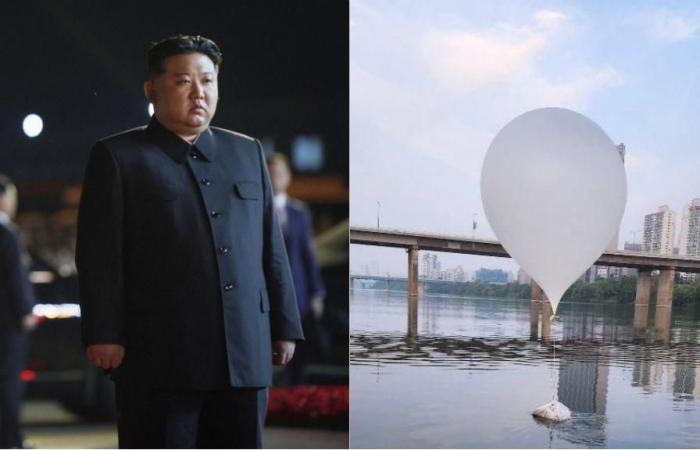Beijing, June 27, 2024 – There are wars and wars. A truly unusual but also very dangerous one is that of the North Korean leader Kim Jong Unwhich since May 28th launches air balloons towards Seoul full of rubbish and excrement, as retaliation for anti-Pyongyang leaflets sent by North Korean defectors and activists to the South.
In the night between Tuesday and Wednesday North Korea he launched another 250, creating alarm at the international airport of Incheon and the capital.
In a month, around 2,000 balloons full of waste have been launched and this is the sixth operation since the end of May. The South Korean Joint Chiefs of Staff Command once again reported the permeability of the inter-Korean border.
On the left Kim Jong-Un and on the right a balloon full of excrement launched over Seoul
Learn more:
Ukraine, Moscow: “US rocket launchers and foreign specialists hit”. North Korea ready to send personnel

The alarm it is above all of a hygienic-sanitary nature: South Korean intelligence has studied the waste of recent weeks which, as expected, has provided an insight into the precarious hygienic-sanitary and food conditions of the hermit country. In the bags the North Koreans mainly put material from landfill, manure and human excrement, results infested with parasites and worms of the digestive system. Additionally, pieces of threadbare clothing and underwear that had been patched numerous times.
About 100 balloons, which they mainly carried pieces of waste paper, landed in the South Korean capital and in the northern part of Gyeonggi province. At 9 in the morning (2 in Italy), however, they were all on the ground, but the real problems arose with the alarm started at 1.46 am, in the middle of the night, when a balloon ended up near Terminal 2 of Incheon airport: the three runways of the airport were closed as a precaution, flights were suspended until 4:44. Given the time and the few take-offs and landings, the disruption was limited: only nine cargo and passenger planes were diverted to other airports. A Command official reported that a single package of waste contained more than 7,000 pieces of low-quality paper.
In response to the North’s campaign, on June 9, for the first time in six years, South Korea blared the anti-Pyongyang campaign with the use of loud speakers at the border. But the broadcasts did not continue in an attempt to avoid an escalation. The South Korean military has made clear that it is ready to conduct counter-propaganda at any time and warned that the response will depend on North Korea’s actions.
Tests for the development of multiple warhead missiles completed
North Korea meanwhile reported successful conduct on Wednesday a missile test on the capacity of multiple warheads, contradicting Seoul’s assessment of its failure. The North’s Missile Administration “successfully conducted the separation and control tests of the guidance of individual mobile news outlets,” the official KCNA news agency said. The operations were aimed “to ensure Mirv capability,” relating to independently targetable multiple reentry vehicle technology, which allows a single ballistic missile to launch multiple warheads at different targets.
The announcement, however, is contrary to the judgments of the Seoul military on the explosion which instead occurred in mid-air. Joint Staff Command officials said on Wednesday that the missile was launched from an area in or around Pyongyang at around 5.30am local time, but exploded over the Sea of Japan after flying for approximately 250 kilometres. Indeed, the most accredited hypothesis from Seoul is that the test would have concerned a hypersonic missile.
Instead, the North said the test “used the first stage engine of an intermediate-range solid-fuel ballistic missile within a range of 170 to 200 kilometers.” The separate mobile warheads were correctly guided towards three destination coordinates, the KCNA said. The launch was overseen by Pak Jong-chon, vice chairman of the Workers’ Party’s Central Military Commission, and Kim Jong-sik, first deputy director of the party’s Central Committee department. “Improving MIRV capability is a very important defense technological task and a top priority of the Central Committee,” the KCNA concluded.






